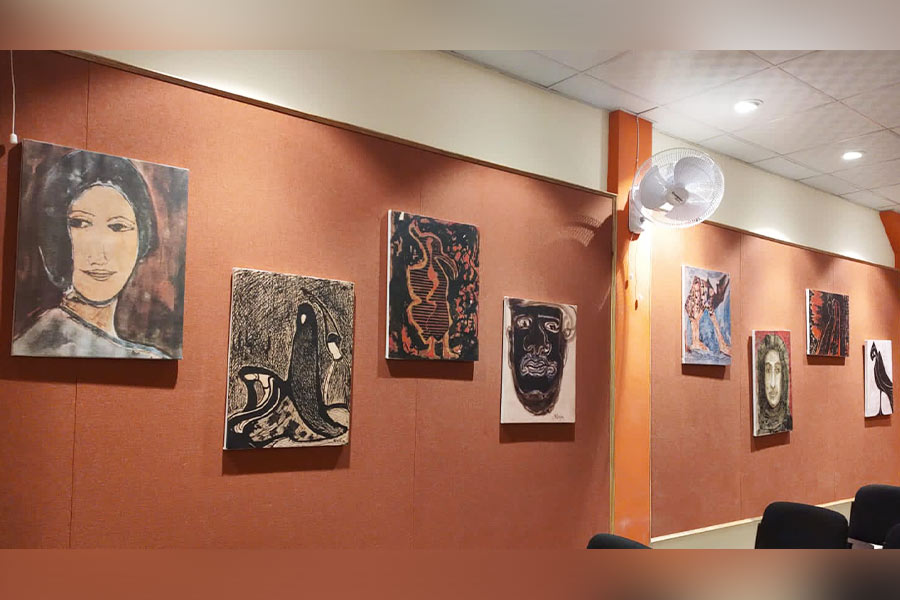Benodebehari Mukherjee’s longest and oldest handscroll on view at the Kolkata Centre for Creativity off EM Bypass has drawn many people.
Measuring 13 metre, Scenes of Santiniketan isperhaps the earliest surviving complete scroll by theartist.
An inscription on the inner side of the protective flap reads: Scenes from Santiniketan by Benode Mukherjee 1924. It is unclear whether the inscription was written by the artist or its first owner and the date, even if not exact, is not far off the mark.
The scroll begins at the right end and progresses to the left as Japanese and Chinese scrolls do.
The exhibition is due to travel to Santiniketan on July 10 and then to Kochi (Kerala) in August.
“The handscroll is an innovation of the East Asian artists. Among Indian artists Benodebehari Mukherjee is the one who has used it most creatively,” said R. Siva Kumar, who curated the exhibition titled ‘Scenes from Santiniketan & Benodebehari’s Scrolls’.
Siva Kumar also gave a talk titled Landscape and theArtist’s Self: Benodebehari’s Engagement with the Santiniketan Countryside, on Saturday.
“I first saw the newly discovered scroll in 2017 and recognised it. This scroll by Benodebehari helps us look at his art anew. I took a year to write the text to the scroll and then came the pandemic. We planned the exhibition and a publication. While the exhibition would revolve around the newly discovered scroll, we decided to bring all the other scrolls by Benodebehari,” said the curator.
The scroll on paper is pasted on a white background and encased in a glass display box. One has to begin viewing the scroll from the right and inch leftwards.
An audio guide helps the viewer understand the painting in sections.
“Benodebehari decided to paint nature, unlike other fellow artists of his time. He painted this scroll in 1924, a pioneering work since there were no significant landscapes done then. Abanindranath started painting landscapes about 10 years later. The modern Indian art scroll was an important juncture in the art movement,” said Siva Kumar.
The first person to move away from Bengal School was Rabindranath Tagore, said Siva Kumar.
“He urged everyone to paint the rural landscape and its people. Tagore pinned his hopes on Nandalal Bose and he took charge of Kala Bhavana. Benodebehari was its first student and he realised Tagore’s vision. Satyajit Ray came to Santiniketan and he was put up at the hostel from where he could see Benodebehari’s mural on Kala Bhavana’s ceiling and it changed his perspective of Bengal School. Benodebehari is still being discovered,” the curator said.
The artist’s grandson, Debasis Bhattacharya,who would write to him regularly, on Saturday spokeof his relationship with his dadu.
“Dadu taught me to draw through his letters. During the sixties, I was studying at the Calcutta Medical College and staying at a hostel on College Street. I would sketch and send them to him at Santiniketan.... He would run his fingers on them. I would write to him about the political turmoil of the times. He would read all that but never advised anything. He knew I admired Picasso, he told me to look at Goya’s pictures. He would teach me how by changing the positions of the subjects in my drawing the entire perspective of my work would change,” he narrated.
After Satyajit Ray made the documentary Inner Eye on his mastermoshai, Benodebehari had asked: “Is Satyajit very popular? I have been getting interview calls from art critics in Calcutta ever since he made his film.”
Artist Jogen Chowdhury feels that “We are lucky that we can see how Santiniketan was through the eyes of Benodebehari.”
Historian Sugata Bose talked of Nandalal’s portrait of his student.
“When I think of Benodebehari, I think of Nandalal’s portrait of the student crouching in front of his work, the power of the visual imagination that Satyajit Ray captured in his document. How Benodebehari transcended his disability, he was like Beethoven who was deaf yet made music. Benodebehari continued to work till his last day despite becoming totally blind.” said the historian.






